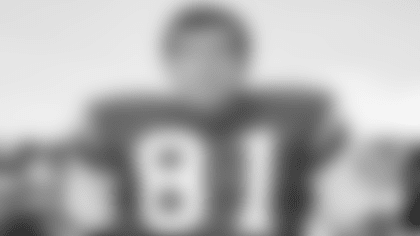
Gerry Philbin, the undersized, big-hearted, highly productive and well-decorated defensive end for almost one stellar decade with the New York Jets of the Sixties and Seventies, has died. He was 83 years old.
Philbin, who wore No. 81 and played LDE for all 109 starts and 112 games of his nine Jets seasons, became one of the well-recognized names on the Jets' defensive front seven that flowed off fans' tongues as the Green & White defense and the Jets as a team proceeded from Philbin's rookie season of 1964 through to their Super Bowl III victory over the Colts in Miami and through the '72 season before he played one last campaign with the Eagles in '73.
"I got the most out of how hard I worked, because I was a little disadvantaged with size and overcame it," Philbin told Jim Gehman in a newyorkjets.com story from 2018 about what made him most proud of his career. "And then just accomplishing most of my goals that I set. I wanted to be an All-Star. I wanted to win the Super Bowl. And the personal goals of getting elected to the All-Time AFL Team. And then finally, becoming a Ring of Honor recipient with the Jets. All those things I cherish a lot."
Philbin was indeed selected to play in the AFL All-Star Games after the 1968 and '69 seasons. He was named first-team defensive end on the all-time All-AFL squad. More than four decades later, he was selected as a member of the Jets' second Ring of Honor Class, being inducted into the team shrine on Oct. 17, 2011, along with fellow defensive partner LB Larry Grantham as well as WR Al Toon and RB Freeman McNeil.
A Teammate of Many Skills
Over the years, many of Philbin's teammates painted a glowing portrait of the player in different hues matching his multiple talents. He'll probably be most remembered as one of the AFL's great pass-rushers before the 1970 merger with the NFL.
"Gerry's got the knack of penetration, getting to the ball," said Weeb Ewbank, the Pro Football Hall of Fame head coach, in the book "The Other League: The Fabulous Story of the American Football League." "He never quits. He always rushes. He's got heart and pride, a will to win. He's always chasing the ball."
That resulted in some amazing metrics that are hard to find in the "unofficial" mist of the AFL and NFL back in the day.
Individual defensive sacks didn't become official until 1982, but official or unofficial, the quarterbacks he toppled in his AFL and NFL days surely felt the sacks. Philbin unofficially recorded 64.5 regular-season sacks according to team records, fourth-most in franchise history.
And by his coaches' film breakdown, in four consecutive seasons, he registered double-digit sacks — 10.5 in '66 followed by 12 in '67, 19 in the Super Bowl season, and 12 sacks in '69. Again unofficially, Philbin and Verlon Biggs are the only players in franchise history to get 10-plus sacks in four consecutive seasons. Mark Gastineau did it five times in six seasons, coming up shy only in the strike-shortened '82 season. And the 19 sacks by the team's count in '68 was the franchise record until Joe Klecko notched 20.5 in 1981.
"I had a unique style to rush the passer," Philbin (6-2, 245) remembered before his ROH induction. "I liked to do the spin move on the inside a lot. I think the quickness helped me, not being as big as some of the linemen."
LB Larry Grantham, a first-team All-AFL player who died in 2017, recalled another one of Philbin's relentless qualities.
"I always remember Gerry down on the goal line," Grantham said in 2011. "He'd always get penetration and that would really help stop any kind of running play to his side. He rushed the passer great, he played the run great, and he gave you 120 percent every play."
"A Damn Tough Player"
John Schmitt, the center for those Jets teams of yore, reflected today on Philbin's toughness.
"I do remember when we played the Kansas City Chiefs in the playoff game [after the 1969 season] — he had a separated shoulder. They made up a leather harness that was a half-inch thick that was wrapped around his chest, and they had chain-link fence holding the leather arm piece to the chest piece. You never saw such a barbaric thing. And he played the whole game against Kansas City. ... He was a damn tough player and I loved the man."
"He was one of the best teammates I ever had with the Jets, and I played right beside him," said Ralph Baker, the Jets' left-side LB at the time. "I really believe he should've been a Hall of Famer. He was just a good guy, a regular guy who worked hard and shared his feelings. When teammates needed to be set straight, Gerry was the guy to do it."
Another Jets head coach had fond memories of No. 81 from when he used to hang with the Green & White in the late Sixties. That was Rex Ryan, HC of the Jets from 2009-15 whose father, Buddy, helped develop Philbin at UB, then worked with him again as Ewbank's and the Jets' DL coach beginning in '68.
"When you talk about a relentless motor and that Jet mentality, that was Gerry Philbin," said Rex, who has listed Philbin as one of his three all-time favorite Jets from that 1968 team he hung out with while his father, Buddy, coached up Ewbank's and the Jets' D-line.
"His Motor Never Stopped"
Underlying Philbin's entire Jets legacy was the intensity with which he pursued his pro football goals. Frank Ramos, the Jets' longtime public relations director, said, "Nobody at the time on our team weightlifted. He was up at Buffalo, and I think he only weighted 215. But he built himself up and became a great player for us. He just never stopped, his motor never stopped."
Philbin was a Northeasterner for a large part of his life. He was born in Pawtucket, RI, and attended the University at Buffalo, where he mostly rooted for the Giants, until the Jets "showed me a lot more respect," told him he wasn't too small in stature to play for them, then drafted him in the third round (19th overall) of the '64 AFL Draft. The Lions took him 33rd overall in that year's NFL Draft, but as Philbin said: "There was never any doubt in my mind that I was going to sign with the Jets."
After his playing career, he sold real estate in Florida, moved back to the Northeast and to New Hampshire, then back to Long Island, where he owned a sand and gravel business, before returning to the Sunshine State and Palm Beach Gardens to be near to his children in his golden years.
Schmitt, one of the on-field and emotional leaders of the Jets' Super Bowl era, put it well when he said of Philbin: "He was a man's man, he was a good father, he was a great teammate. And he was one of the leaders on our team."














